Substrates Used for HEMT Fabrication
A Phd candidate requested the following quote:
Can you send me a quotation for each heterostructure?
- 2" bulk GaN wafer
- 4" GaN template
Non-Polar Freestanding GaN
Substrates (A-plane)
HEMT Structure on Sapphire
- 2" AlN wafer on Sapphire
- 2" GaN wafer on Sapphire
(Undoped)
- 2" GaN wafer on sapphire (Si-
doped)
- 2" GaN wafer on sapphire (Mg-
doped)
- 2" GaN wafer on sapphire
(undoped)
- HEMT stucture on Si substrate
- HEMT stucture on SiC substrate
- 2 " Gallium Nitride Blue or
Green LED wafer
Reference #211933 for specs and pricing.
Get Your Quote FAST! Or, Buy Online and start researching today!
What is HEMT?
A high electron mobility transistor (HEMT) is a type of transistor that is commonly used in high-frequency and high-power applications. It is also known as a heterojunction field-effect transistor (HFET) or modulation-doped field-effect transistor (MODFET).

The HEMT is based on a heterojunction structure, which means that it has two or more layers of materials with different bandgaps. The most common materials used in HEMTs are Gallium Nitride (GaN) and Gallium Arsenide (GaAs).
The HEMT operates by using a voltage to control the flow of electrons between the source and drain terminals. The unique feature of the HEMT is its extremely high electron mobility, which is achieved by the use of the heterojunction structure. This high mobility results in high switching speeds and high amplification capabilities, making it ideal for use in microwave and millimeter-wave applications such as satellite communications, radar systems, and wireless networks.
HEMTs are also used in power amplifiers for cellular base stations, as well as in high-power microwave devices for scientific and military applications. They offer many advantages over other types of transistors, including low noise, high linearity, and high efficiency.
What Substrates are Used to Fabricate HEMT Transistors?
High electron mobility transistors (HEMTs) can be fabricated on a variety of substrates, but the choice of substrate depends on the specific application and performance requirements. The most commonly used substrates for HEMT fabrication are:
-
Gallium Arsenide (GaAs): GaAs is a popular substrate for HEMTs because it has a high electron mobility and a high electron saturation velocity. HEMTs fabricated on GaAs substrates typically operate at high frequencies and exhibit high output power.
-
Indium Phosphide (InP): InP is another commonly used substrate for HEMTs, particularly for high-frequency and high-speed applications. HEMTs fabricated on InP substrates typically offer low noise and high linearity.
-
Silicon Carbide (SiC): SiC is a wide-bandgap semiconductor that is suitable for high-power and high-temperature applications. HEMTs fabricated on SiC substrates can operate at high frequencies and exhibit high output power, making them suitable for applications such as power amplifiers and high-frequency switching.
-
Silicon (Si): Although Si is not as popular as GaAs, InP, and SiC for HEMT fabrication, it is still used for some applications, particularly for low-cost, high-volume production. HEMTs fabricated on Si substrates typically offer low noise and low power consumption.
In summary, the choice of substrate for HEMT fabrication depends on the specific application and performance requirements, with GaAs, InP, SiC, and Si being the most commonly used substrates.
How a Gallium Nitride (GaN) HEMT Work?
A Gallium Nitride (GaN) high electron mobility transistor (HEMT) works by using a heterojunction structure to achieve high electron mobility and high-speed switching. Here's a simplified description of how a GaN HEMT works:
-
The device consists of a thin GaN layer deposited on a substrate, such as sapphire or SiC.
-
The GaN layer is doped with impurities, creating a two-dimensional electron gas (2DEG) channel at the interface between the GaN and the AlGaN layer.
-
A gate electrode is placed on top of the AlGaN layer, separated from the 2DEG channel by a thin insulating layer.
-
When a voltage is applied to the gate electrode, an electric field is created in the AlGaN layer, which modifies the electron density and hence the conductivity of the 2DEG channel.
-
By controlling the gate voltage, the current flowing through the 2DEG channel can be modulated, allowing the device to act as a switch or an amplifier.
The unique feature of GaN HEMTs is their high electron mobility, which is achieved by the use of the heterojunction structure. This high mobility results in high switching speeds and high amplification capabilities, making it ideal for use in high-frequency and high-power applications such as satellite communications, radar systems, and wireless networks.
In summary, GaN HEMTs use a gate voltage to control the flow of electrons in a 2DEG channel created at the interface between a GaN layer and an AlGaN layer, allowing for high-speed switching and amplification.

